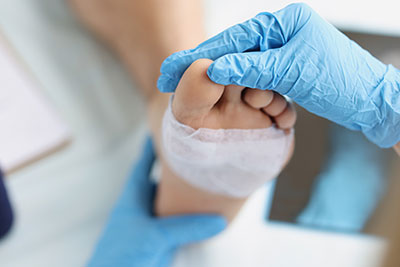- Home
- Foot & Ankle Conditions
- Foot Ulcers
Foot Ulcers
- Published 11/29/2023
- Last Reviewed 5/15/2024

What are foot ulcers?
Foot ulcers are wounds and lesions on the feet that keep returning or do not entirely heal. Foot ulcers result from broken skin that leaves the cells in your feet prone to infections and damage. They are the leading cause of foot infections in adults.
Are you worried about recurring or non-healing wounds on your foot?
Getting a recurring or non-healing wound checked out by a podiatric wound expert is better than waiting until the condition worsens and becomes harder to treat. If left untreated for too long, the infection can spread into the bone (osteomyelitis), causing serious complications and, in some cases, amputation.
20,818 Total 1st Party Reviews / 4.9 out of 5 Stars
 Dr Bavarian was kind and helpful with my foot problem. I'm from Phoenix and came over to LA because I heard he could help. He ...Mary W.
Dr Bavarian was kind and helpful with my foot problem. I'm from Phoenix and came over to LA because I heard he could help. He ...Mary W. Great first experience!Augustine W.
Great first experience!Augustine W. I've been a patient of Dr. Franson for some years and I've been very pleased with his care.Virginia M.
I've been a patient of Dr. Franson for some years and I've been very pleased with his care.Virginia M. Dr. Bob Baravarian and his staff are fantastic!Todd B.
Dr. Bob Baravarian and his staff are fantastic!Todd B. Dr. Jafary is absolutely the best. He not only takes the time to listen, process, and diagnose your problem, but he does his re...Bonnie G.
Dr. Jafary is absolutely the best. He not only takes the time to listen, process, and diagnose your problem, but he does his re...Bonnie G. Having consulted four podiatrists before visiting UFAI, I was altogether thrilled to find a doctor who actually listened to me ...Christie S.
Having consulted four podiatrists before visiting UFAI, I was altogether thrilled to find a doctor who actually listened to me ...Christie S. Thank you for the thorough checkup and for explaining everything so clearly!Daphne T.
Thank you for the thorough checkup and for explaining everything so clearly!Daphne T. GreatCharles M.
GreatCharles M. Fair. Doctor did not fully explain condition or take enough timeAnnette H.
Fair. Doctor did not fully explain condition or take enough timeAnnette H. Prefer your Sherman Oaks office over Santa Monica. Wait times are minimal there compared with Santa Monica.Yvonne E.
Prefer your Sherman Oaks office over Santa Monica. Wait times are minimal there compared with Santa Monica.Yvonne E. Everyone does an excellent jobScott B.
Everyone does an excellent jobScott B. Simply great. Dr. Bob has a wonderful bedside manner as does everyone in the office. Medically excellent care.Marjorie H.
Simply great. Dr. Bob has a wonderful bedside manner as does everyone in the office. Medically excellent care.Marjorie H.
-
 Listen Now
Is Bunion Surgery Covered By Insurance?
Read More
Listen Now
Is Bunion Surgery Covered By Insurance?
Read More
-
 Listen Now
Pediatric Bunion Surgery
Read More
Listen Now
Pediatric Bunion Surgery
Read More
-
 Listen Now
15 Summer Foot Care Tips to Put Your Best Feet Forward
Read More
Listen Now
15 Summer Foot Care Tips to Put Your Best Feet Forward
Read More
-
 Listen Now
What Are Shin Splints?
Read More
Listen Now
What Are Shin Splints?
Read More
-
 Listen Now
Non-Surgical Treatment for Plantar Fasciitis – What Are Your Options?
Read More
Listen Now
Non-Surgical Treatment for Plantar Fasciitis – What Are Your Options?
Read More
-
 Listen Now
Bunion Surgery for Athletes: Can We Make It Less Disruptive?
Read More
Listen Now
Bunion Surgery for Athletes: Can We Make It Less Disruptive?
Read More
-
 Listen Now
Moore Balance Brace: Enhance Stability and Prevent Falls for Better Mobility
Read More
Listen Now
Moore Balance Brace: Enhance Stability and Prevent Falls for Better Mobility
Read More
-
 Listen Now
Swollen Feet During Pregnancy
Read More
Listen Now
Swollen Feet During Pregnancy
Read More
-
 Listen Now
Top 10 Non-Surgical Treatments for Morton's Neuroma
Read More
Listen Now
Top 10 Non-Surgical Treatments for Morton's Neuroma
Read More
-
 Listen Now
Bunion Surgery for Seniors: What You Need to Know
Read More
Listen Now
Bunion Surgery for Seniors: What You Need to Know
Read More
-
 Listen Now
Do Blood Pressure Medicines Cause Foot Pain?
Read More
Listen Now
Do Blood Pressure Medicines Cause Foot Pain?
Read More
-
 Listen Now
What To Do When Your Toenail Is Falling Off
Read More
Listen Now
What To Do When Your Toenail Is Falling Off
Read More
-
 Listen Now
How To Tell If You Have Wide Feet
Read More
Listen Now
How To Tell If You Have Wide Feet
Read More
-
 Listen Now
Should I See a Podiatrist or Orthopedist for Foot Pain and Ankle Problems?
Read More
Listen Now
Should I See a Podiatrist or Orthopedist for Foot Pain and Ankle Problems?
Read More
-
 Listen Now
How Many Steps Do I Need A Day?
Read More
Listen Now
How Many Steps Do I Need A Day?
Read More














